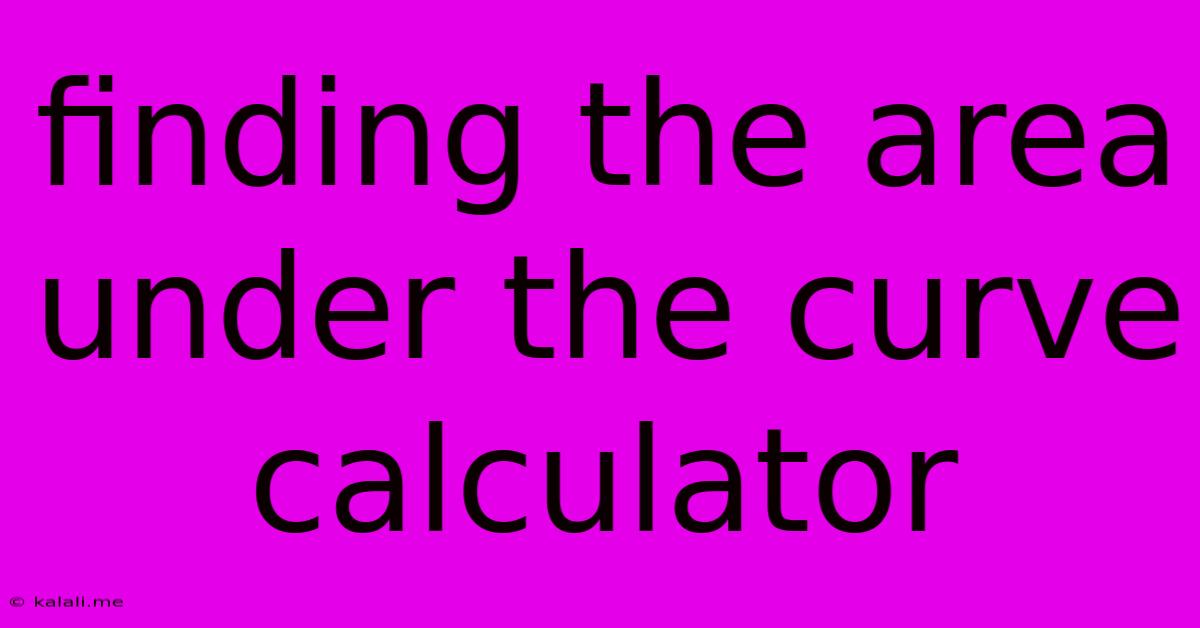Finding The Area Under The Curve Calculator
Kalali
Jun 13, 2025 · 3 min read

Table of Contents
Finding the Area Under the Curve Calculator: A Comprehensive Guide
Finding the area under a curve is a fundamental concept in calculus, with applications spanning various fields like physics, engineering, and economics. Manually calculating this area can be tedious and complex, especially for intricate curves. Fortunately, numerous online calculators can simplify this process. This guide explores the use and benefits of area under the curve calculators, focusing on their functionality and the mathematical principles behind them.
This article will cover the following key aspects: understanding the concept of definite integrals, choosing the right calculator, common applications, and limitations of these tools.
Understanding Definite Integrals and Area Under the Curve
The area under a curve between two points, say a and b, is essentially the definite integral of the function representing the curve between those points. Mathematically, it's represented as:
∫<sub>a</sub><sup>b</sup> f(x) dx
This integral represents the summation of infinitely small rectangles under the curve, providing an accurate measure of the area. While simple functions may allow for manual integration, complex curves require numerical methods, which are precisely what area under the curve calculators employ.
Types of Area Under the Curve Calculators and Their Features
Several online calculators offer this functionality. They differ in features such as:
- Function Input: Some accept standard mathematical notation, while others may require specific input formats.
- Integration Methods: Different calculators might utilize various numerical integration techniques (e.g., trapezoidal rule, Simpson's rule) with varying degrees of accuracy.
- Visualization: Many calculators provide graphical representations of the curve and the calculated area, enhancing understanding.
- Advanced Features: Some may include options for handling piecewise functions, polar coordinates, or even double integrals (calculating the volume under a surface).
Choosing the Right Calculator for Your Needs
Selecting the appropriate calculator depends on several factors:
- Complexity of the Function: For simple functions, a basic calculator might suffice. For complex functions or those involving multiple variables, a more advanced calculator is necessary.
- Required Accuracy: The precision needed for the area calculation will influence the choice. Some calculators offer adjustable precision settings.
- User Interface: User-friendliness is paramount. A clear and intuitive interface simplifies the process and reduces the potential for errors.
- Additional Features: Consider whether you need visualization tools, support for specific function types, or other advanced functionalities.
Common Applications of Area Under the Curve Calculators
These calculators find wide use across diverse disciplines:
- Physics: Calculating displacement from velocity-time graphs, work done from force-displacement graphs.
- Engineering: Determining the area of irregularly shaped components, calculating fluid flow rates.
- Economics: Computing total revenue from marginal revenue curves, evaluating consumer surplus.
- Statistics: Finding probabilities associated with probability density functions.
- Data Analysis: Estimating the area under empirical data distributions.
Limitations of Area Under the Curve Calculators
It's important to acknowledge the limitations:
- Numerical Approximations: Most calculators employ numerical methods, resulting in approximate, not exact, results. The accuracy depends on the chosen method and the complexity of the function.
- Function Restrictions: Not all calculators support all types of functions. Some may have limitations on the types of functions they can handle.
- Potential for Errors: Incorrect function input or inappropriate parameter selection can lead to inaccurate results. Always double-check your inputs and compare with known results if possible.
Conclusion
Area under the curve calculators are invaluable tools for simplifying the process of calculating definite integrals. By understanding their capabilities and limitations, you can effectively utilize these calculators to solve a wide range of problems in various fields. Remember to carefully choose a calculator that matches your specific needs and always double-check the results for accuracy.
Latest Posts
Latest Posts
-
Which Of The Following Is Not True Of Mutual Funds
Jun 13, 2025
-
What Is The Lcm Of 12 And 28
Jun 13, 2025
-
Hybridization Of The Central Atom In So2
Jun 13, 2025
-
Transfers Motion From The Pushrods To The Valves
Jun 13, 2025
-
How Many Minutes Is A Football Game
Jun 13, 2025
Related Post
Thank you for visiting our website which covers about Finding The Area Under The Curve Calculator . We hope the information provided has been useful to you. Feel free to contact us if you have any questions or need further assistance. See you next time and don't miss to bookmark.